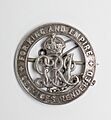Silver War Badge facts for kids
The Silver War Badge was a special award given in the United Kingdom and the British Empire during World War I. It was for soldiers, sailors, and airmen who had to leave the military because they were hurt or got sick while serving their country.
Contents
Why Was the Badge Created?
This badge, sometimes called the "Discharge Badge" or "Services Rendered Badge," was first given out in September 1916. It came with an official paper that said the person deserved it. If someone had fought in a war zone, they also got a "King's Certificate of Discharge" saying they "Served with honour."
The badge was a large, shiny silver pin meant to be worn on regular clothes. It was like a thank you from the King for serving in the war and getting injured or sick.
One big reason for the badge was to help soldiers who had been honorably discharged. In the early parts of the war, some women would give white feathers to men they saw in civilian clothes. This was meant to suggest the men were cowards for not fighting. But many soldiers had been hurt or become ill and could no longer serve, even if their injuries weren't obvious. The Silver War Badge helped these former service members show that they had done their duty. It was worn on the right side of their chest. Soldiers were not allowed to wear the badge on their military uniforms.
The badge has the King's special symbol, "GRI," which stands for Georgius Rex Imperator (meaning George, King and Emperor). Around the edge, it says "For King and Empire - Services Rendered."
Each badge had a unique number on the back. The government kept records of who received each badge. Countries like Canada, New Zealand, Australia, and South Africa also gave out these badges. Their badges had a letter before the number, like 'A' for Australia or 'C' for Canada. If a badge was lost, it usually wasn't replaced. But if found, it would be sent back to the government to be returned to its owner.
A similar award, called the King's Badge, was given out during World War II. It also came with a certificate but didn't have individual numbers like the World War I badge.
Finding Records for the Silver War Badge
If you want to find out about someone who received a Silver War Badge, you can look at special records. These records are often kept at The National Archives in the United Kingdom.
There are two main ways the badge might be listed:
- It could be on a regular "medal card," which lists all the medals a soldier received.
- It could also be on a special "Silver War Badge Card" created just for this badge.
If there isn't a Silver War Badge Card, you might find details about a soldier's discharge on a "Silver War Badge Roll." This roll would usually tell you the badge number, why the person was discharged, and the date they left the service.
You can often access Silver War Badge Cards online through The National Archives website. These cards usually show the discharge date, the reason, and the badge number, making it easier to find information.
For soldiers from Australia, their records can be found through the Australian War Memorial.
Reasons for Discharge
The military had specific rules, called "King's Regulations," for why someone could be discharged. There were many different reasons. On a Silver War Badge Card, you might see something like "KR (xvi)." This means "King's Regulations, section 16."
Here are some of the common reasons a soldier might have been discharged and received a Silver War Badge:
- (xvi) No longer physically fit for war service (this was a very common reason for the badge).
- (xvii) Not needed by the military anymore (especially if they had health problems since joining).
- (xxv) Their services were no longer required.
- (xxix) When the war ended and they were sent home (demobilization).
Some other reasons for discharge included:
- (iii) Not likely to become a good soldier.
- (ix) Not suited for the duties of their unit.
- (xxi) Their time of service was simply over.
- (xxiv) They had reached the age limit for serving.
How Many Badges Were Issued?
About 1,150,000 Silver War Badges were given out in total. People had to apply for the badge, and their application had to be approved. Most badges were given for reason (xvi) – not being physically fit for war service.
The numbers on the back of the badges changed over time:
- From September 1916 to March 1918, about 335,000 badges were issued with just a number.
- From March 1918 to September 1918, another 115,000 badges were issued.
- From September 1918 to December 1919, about 450,000 badges had a 'B' before the number.
- From December 1919 to January 1920, about 5,000 badges had an 'O' before the number.
- From January 1920 to March 1922, about 70,000 badges went back to having just a number.
After April 1918, other groups also started receiving the badge:
- Members of the RAF (Royal Air Force) received badges with 'RAF' before the number (over 10,000 issued).
- The Royal Navy had badges with an 'RN' prefix (at least 43,000 issued).
- Even some civilians who worked with the military, like those in the RAMC (Royal Army Medical Corps), female nurses, and staff from groups like the VADs and QMAAC, could receive the badge.
- Badges given to South African soldiers had an 'SA' prefix, and Canadian soldiers had a 'C' prefix.
See also
- Lists of abbreviations used on British Empire World War I medals
Resources
- Search over 5 million campaign medal cards on The UK National Archives' website.
- Links to NAA via AWM – Australian War Memorial with links to the National Archives of Australia, for service and formation specific details.
Images for kids




